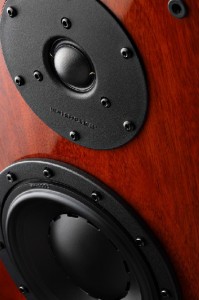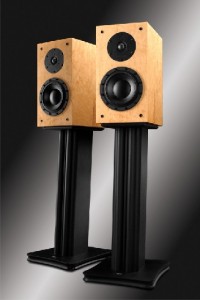Last October I published a speaker monitor shootout. Of the two finalists, we have already reviewed the Ascend Acoustics Sierra 1’s in the September issue. Therefore, I thought it was time to take an in-depth listen at the Swans. The US distributor is The Audio Insider, run by Jon Lane. TAI personnel have been involved with Swan since 1994, and we acquired exclusive rights to market Swan in the ID channel in 2003. TAI, virtually the sole North American Swan supplier, specified the D2.1se and upcoming siblings back in 2004. Lane’s been in high-end since 1980. His direct sales experience goes back to the early Eighties, some twenty years, and he was on the Diva design team for them[TAI?] in late 1999.
Specifications:
- Frequency Response: 40Hz-20kHz
- Sensitivity: 85dB
- Nominal Impedance: 8 Ohms Power Handling: 10-150W Finish: Rosewood
- Dimensions: 385 x 205 x 303mm Dimensions: 15.2 x 8.0 x 11.9in Net Weight: 11kg / 24.0lbs each
- Finishes: Piano Black, Rosewood (+$50), Birdseye Maple (+$150) Price: $899 pair
I will disclose up front that under agreement due to proprietary technology, I gave my word not to remove the drivers and peek inside the cabinet. I assume the reasoning is based upon the fact that Swan builds drivers and other speaker components for a number of manufacturers and would like to keep some technologies for themselves.MM
What I can reveal is that the exterior cabinet is stunning. The Rosewood red stain is rich, covered in several layers of high gloss clear-coat finish. Not only are the speakers incredible to look at, the finish has such a high sheen that photographing it takes some real skill. The veneer has a single-piece look to it, and the natural variety of red hues make it easier to blend with other furniture than one might think.
The drivers consist of a tweeter that “includes a German silk dome, ferrofluid cooling, a decompression chamber, and critically designed motor and suspension.” The driver consists of a butyl rubber surround and [omit] a hybrid neodymium/ferrite motor, which Swan claims improves linear operation and limits distortion. The mid-driver’s appearance is similar to ones used by Dynaudio, as well as certain Totems, among others.
The Sound of HiVi 2.1SE
In my conversations with Jon Lane, he emphasized that these are not bookshelf, but true stand monitors. For those of you thinking that you may want to try them on a shelf, I would suggest looking at another speaker.I tried listen ing to them on my fireplace mantel, and true to Jon’s word, the speakers were lifeless in comparison to how they sounded right from the start on my vaunted Celestion Si stands.
Normally, I break-in monitors by letting them play 24/7 in a closet with a blanket over them. Based on circumstances I decided treat them like floorstanders and let them play through the night on my family room rig. After two weeks, I deemed them ready for prime time. It took several days for me to find the best position for each monitor in my living room. I was always just a hair “out of focus” with the Swan 2.1SEs. The sound was good, but the imaging and detail were slightly fuzzy. I will admit that this was the most time-consuming placement I have encountered in the two years of A$$A. Finally, instead of changing rather small distances of the speakers themselves, I changed listening position. I brought in a dining room chair and placed it in front of the love seat I was sitting in. The combination of placement from the back wall, and the increase in height brought the sound into focus.
The amplifiers used were my Onix SP3 tube and a modified PS Audio Trio C-100, along with my modded Jolida JD-100 cd player.
With the position tuned in, I was finally able to get to some serious listening. Lately, the Eagles Long Road From Eden has been in heavy rotation. The harmonies of disc one are truly outstanding, a definite missing element in music today. Right off the bat, the Swan 2.1SEs present the vocals slightly lower in the octave, very similar to my experience with the Polk LSi7s. This voicing, I believe, is due to the true monitor size of the cabinets and the high quality mid driver Swan employs.
When it comes to high frequencies, most of us will pick a cymbal as a starting point for determining smoothness. The silk dome tweeter has a natural tendency towards a less bright presentation in comparison to metal domes. The trick is to find that happy medium where the details exist but aren’t embellished. The Swan 2.1SEs do a fine job finding that common ground, with but a slight tilt towards a softer treble. One won’t confuse them with the Totem Rainmakers, but more on that later.
Donald Fagan’s The Nightfly has several tracks that can put the tweeter and crossover to the test. “Ruby Baby” came across as lively, including the higher edges of Fagan’s voice. Something I remember hearing way too many years ago was done on purpose. [I don’t understand this sentence. Rework please.]
One of the hardest things to explain to an audio newbie is depth of sound. Until one gets a true experience in a comparison, no amount of words or quality of prose can adequately explain what makes this characteristic so special. The second problem is that usually it takes a speaker priced in the $1300 price point and up to truly begin to share this quality. What I can tell you is that the Swan 2.1SEs have the talent to demonstrate this ability. Not at the same level as, say, the Sonus Faber Cremona Auditor, but what the 2.1SE does have sure is nice to hear.
Since the last part of this review took place during the holidays, I played quite a variety of Christmas music thru the Swan 2.1SEs. Classical music was comfortably handled. The bass capabilities of the monitors allowed for an extra octave to be heard, which normally doesn’t happen with orchestrated music. It’s the prime reason why classical fans eschew monitors in favor of full range speakers (unless a quality sub is used). I can testify that unless the listener wants the deepest of thundering compositions, the Swan 2.1SEs will do just fine.
Bass response is the Swan 2.1SEs forte. They are listed with a bottom-end of 43hz, and when I listened to the Stereophile Test CD, auditory frequencies were easily perceivable at 40hz. With that in mind, I put on Morph The Cat, which, with its richly layered bass instruments, is a great test of any speaker. The Swan’s performance was outstanding; the typical one-note bass of many monitors was replaced with a wide spectrum of variety of bass instruments. The reverberations of different notes on the string bass specifically were a pleasure to hear.
As for rock, The Who’s classic Quadrophenia was an impact-laden experience. Keith Moon’s drumming stood out along with the fine bass work of John Entwistle. The track “5:15” stands out with the Swan 2.1SEs, as individual instruments had a unique sense of place. [change this so you’re not saying ‘stands out’ twice]
Comparisons & Limitations
Over a few evenings, I was able to compare the Swan 2.1SEs to the Totem Rainmakers, which I have in-house for an extended review. It should be noted that the Rainmakers have a smaller cabinet both in width (small difference), and in depth (significant difference). Both speakers were placed on stands, and songs were compared first with one, then the other speaker. The Swans as mentioned before have a lower voicing, and are not as bright as the Rainmakers. They also have more depth and richness to their sound. The xylophones in Steely Dan’s Aja title track are more three dimensional with the Swans. The Rainmakers have better imaging, but I’m not surprised. as Totem products are universally praised and rarely equaled in this area. But keep in mind, different rooms and different equipment make any exact comparison dicey, if not downright impossible.
The Swan 2.1SEs are not a speaker for those who just want to casually set up a plug ‘n’ play system. These speakers require time and patience in order to present their best sonic attributes. Placement less than 3 feet from a wall can yield an unpleasantly boomy bass. Also, I wouldn’t use them in a nearfield setting. My living room (14ft x 16ft) seemed quite perfect for the Swan 2.1SE’s. I did try them in my wife’s s home office (9ft x 11ft), but the sound wasn’t nearly as good. These monitors need some room to reach their potential.
Another factor to consider is electronics. During their break-in phase and just after, they were being run by my vintage Harman Kardon 680i receiver. The match wasn’t a good one. Even with the ultrawideband capabilities and generally beefy transformer, the 85db Swan 2.1SEs limited the HK’s ability to drive the music with precision. Therefore, I recommend quality separates or an equally good integrated amp in order to achieve quality music reproduction. Not to mention stands that can be filled with ballast[is “ballast” the right word? You’re wanting weightedness, not flotation, right?] of some sort. I was lucky enough to spend a couple of days hearing the Swans mated to a Classe CAP 151 integrated (150wpc), and the result was impressive: tight, controlled bass, a rich midrange, and smooth highs.
Final Thoughts about Swan HiVi 2.1SE speakers
The Swan 2.1SEs are the most stunningly veneered speakers I have ever had in my home. The high gloss finish needs to be seen in person to be appreciated. The HiVi series is a completely fresh approach for Swan. With its partnership with The Audio Insider Swan will soon be releasing sibling units starting at CES, and culminating in a full lineup for home theater.
The 2.1SEs offer a serious value for price-conscious consumers. The sound is a rich, full one that defies its price. For classical music fans this may be the first value-priced monitor worthy of listening to without a sub. With its Internet-direct model, The Audio Insider offers the opportunity to experience hearing the Swan 2.1SEs in your own home for 30 days. If you’re willing to spend the time to find the proper positioning, the results can be wonderful. Just make sure to invest in a fine pair of stands, and have a quality amplifier.
Review equipment
- Onix SP3 Tube Amplifier
- Modified Jolida JD-100 cdp
- Swan 2.1SE Monitors
- Aperion Intimus 533-T
- Onix Rocket RS-450’s
- AudioArt Power 1, IC-3, & SC-5
 from affordableaudio, By Mark Marcantonio
from affordableaudio, By Mark Marcantonio


